
Lower Saxony is a German state in northwestern Germany. It is the second-largest state by land area, with 47,614 km2 (18,384 sq mi), and fourth-largest in population among the 16 Länder federated as the Federal Republic of Germany. In rural areas, Northern Low Saxon and Saterland Frisian are still spoken, albeit in declining numbers.

Oldenburg (German pronunciation:[ˈɔldn̩bʊʁk] ; Northern Low Saxon: Ollnborg) is an independent city in the state of Lower Saxony, Germany. The city is officially named Oldenburg (Oldb) (Oldenburg in Oldenburg) to distinguish from Oldenburg in Holstein.

The Rhine-Ruhr metropolitan region is the largest metropolitan region in Germany, with over ten million inhabitants. A polycentric conurbation with several major urban concentrations, the region covers an area of 7,110 square kilometres (2,750 sq mi), entirely within the federal state of North Rhine-Westphalia. The Rhine-Ruhr metropolitan region spreads from the Ruhr area (Dortmund-Bochum-Essen-Duisburg) in the north to the urban areas of the cities of Mönchengladbach, Düsseldorf, Wuppertal, Leverkusen, Cologne, and Bonn in the south. The location of the Rhine-Ruhr at the heart of the European Blue Banana makes it well connected to other major European cities and metropolitan areas such as the Randstad, the Flemish Diamond and the Frankfurt Rhine Main Region.

The Hamburg Metropolitan Region is a metropolitan region centred around the city of Hamburg in northern Germany, consisting of eight districts in the federal state of Lower Saxony, six districts in the state of Schleswig-Holstein and two districts in the state of Mecklenburg-Vorpommern along with the city-state of Hamburg itself. It covers an area of roughly 26,000 square kilometres (10,000 sq mi) and is home to more than 5.1 million inhabitants.
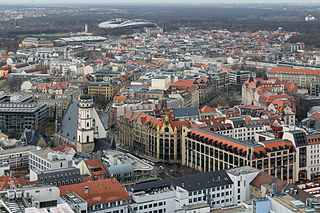
The Central German Metropolitan Region is one of the officially established metropolitan regions in Germany. It is centered on the major cities of Leipzig and Halle, extending over Central German parts of the states of Saxony-Anhalt, Thuringia and Saxony. The Central German metropolitan region is the only one located entirely within the former East Germany. The "region" is not actually a metropolitan area in the geographic sense of the word as an agglomeration of nearby urban areas, rather it is a registered association, the Europäische Metropolregion Mitteldeutschland e.V. whose membership is composed of towns, cities, municipalities, and companies, colleges and chambers of commerce in the central German geographic area, whose representatives vote upon new members. For example, Jena joined the Metropolitan Region in 2009. The registered association owns the management company Metropolregion Mitteldeutschland Management GmbH. As such it forms a planning and marketing framework for the region while retaining the legal independence of its members.

The Rhine-Neckar Metropolitan Region, often referred to as Rhein-Neckar-Triangle, is a polycentric metropolitan region located in south western Germany, between the Frankfurt/Rhine-Main region to the North and the Stuttgart Region to the South-East.
Radio Bremen, shortened to RB is Germany's smallest public radio and television broadcaster and the legally mandated broadcaster for the city-state Free Hanseatic City of Bremen. With its headquarters sited in Bremen, Radio Bremen is a member of the consortium of German public broadcasting organizations, ARD.

Bad Zwischenahn is a town and a municipality in the low-lying Ammerland district, in Lower Saxony, Germany. It is on Zwischenahner Meer, approximately 15 km northwest of Oldenburg and about 70 km south of the North Sea coast.
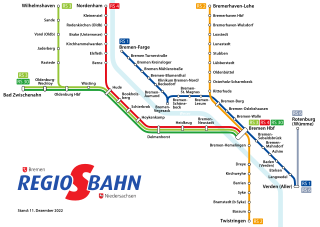
The Bremen S-Bahn is an S-Bahn network in Germany, covering the Bremen/Oldenburg Metropolitan Region, from Bremerhaven in the north to Twistringen in the south and Bad Zwischenahn and Oldenburg in the west. It has been in operation since 2010. This network unified existing regional transport in Bremen as well as surrounding cities, including Bremerhaven, Delmenhorst, Twistringen, Nordenham, Oldenburg, and Verden an der Aller. The network lies completely within the area of the Verkehrsverbund Bremen/Niedersachsen, whose tariff structure applies.
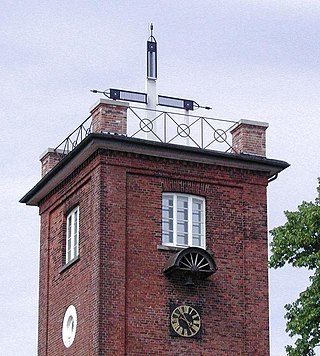
Brake is the district seat of Wesermarsch district in northern Germany.

Bremen Hauptbahnhof is a railway station in the city of Bremen in northwestern Germany. It is the most important rail station for both the city and state of Bremen; InterCityExpress, Intercity, EuroCity, CityNightLine and DB NachtZug services call at the station, which is situated to the Northeast of the city centre. The train services are operated by Deutsche Bahn, NordWestBahn, Metronom and Erixx.

Bremen, officially the City Municipality of Bremen, is the capital of the German state of the Free Hanseatic City of Bremen, a two-city-state consisting of the cities of Bremen and Bremerhaven. With about 570,000 inhabitants, the Hanseatic city is the 11th largest city of Germany and the second largest city in Northern Germany after Hamburg.

Bremerhaven is a city on the east bank of the Weser estuary in northern Germany. It forms an exclave of the city-state of Bremen. The River Geeste flows through the city before emptying into the Weser.
The Stade Region emerged in 1823 by an administrative reorganisation of the dominions of the Kingdom of Hanover, a sovereign state, whose then territory is almost completely part of today's German federal state of Lower Saxony. Until 1837 the Kingdom of Hanover was ruled in personal union by the Kings of the United Kingdom of Great Britain and Ireland.
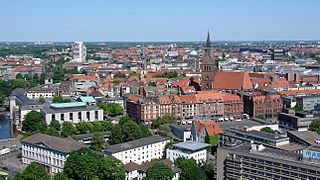
The Hanover–Braunschweig–Göttingen–Wolfsburg Metropolitan Region is an economic and cultural region in Northern Germany. The metropolitan region comprises approximately one third of the area of Lower Saxony, with almost half the inhabitants of the state. It has about 3.9 million people in 20 districts and counties with a total of 431 municipalities and is defined by the German Ministerkonferenz für Raumordnung (MKRO) as a medium urban area in Germany.

The Wunstorf–Bremen railway line is one of the most important lines in the German state of Lower Saxony. It connects the port city of Bremen via Verden an der Aller and Nienburg to Wunstorf, where it connects with the line to Hanover. The 122.3-kilometre-long (76.0 mi), twin-track main line is continuously electrified. The maximum speed is 160 kilometres per hour (99 mph), the maximum axle load is 22.5 tonnes (50,000 lb) and the line is rated as class D4 in the German system of track classification. It was opened on in 1847.
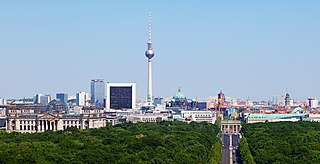
The Berlin/Brandenburg metropolitan region or capital region is one of eleven metropolitan regions of Germany, consisting of the entire territories of the state of Berlin and the surrounding state of Brandenburg. The region covers an area of 30,545 square kilometres (11,793 sq mi) with a total population of about 6.2 million.

Carl Georg Röver was a German Nazi Party official. His main posts were as Gauleiter of Gau Weser-Ems and Reichsstatthalter of both Oldenburg and Bremen.

The Wilhelmshaven–Oldenburg railway is a predominantly double-track, electrified main line in the northwest in the German state of Lower Saxony. It runs to the south from the port city of Wilhelmshaven to Oldenburg.

The 2015 Bremen state election was held on 10 May 2015 to elect the members of the Bürgerschaft of Bremen, as well as the city councils of Bremen and Bremerhaven. The incumbent government of the Social Democratic Party (SPD) and The Greens retained its majority. However, Mayor and SPD leader Jens Böhrnsen resigned due to his party's poor performance, which was significantly below expectations. He was succeeded by fellow SPD member Carsten Sieling.



















